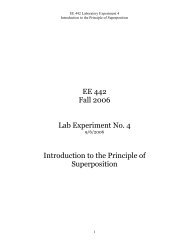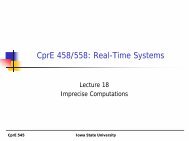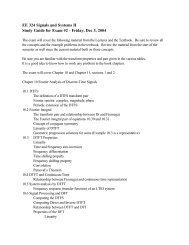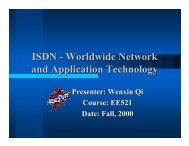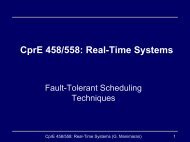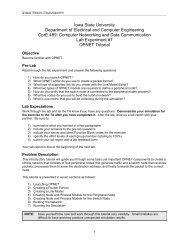Sockets Tutorial PDF file
Sockets Tutorial PDF file
Sockets Tutorial PDF file
You also want an ePaper? Increase the reach of your titles
YUMPU automatically turns print PDFs into web optimized ePapers that Google loves.
The Berkely API (Application Protocol Interface)<br />
Helpful Notes<br />
By<br />
Pallab Datta<br />
Feb 20, 2001
The Berkeley API<br />
An application program interface(API) allows Application programs to<br />
access certain resources through a predefined and preferably consistent<br />
interface.<br />
The socket interface is now available on many UNIX machines.<br />
Another popular socket interface that was derived from BK-socket is<br />
called the Windows Socket or Winsock.<br />
The socket mechanism allows programmers to write appl programs<br />
easily without worrying about the underlying networking details.<br />
In a typical communication session one application operates as a server<br />
and the other application acts as the client. The server provides services<br />
upon request from the client.<br />
Two modes of service : Connection-oriented ,Connectionless<br />
Connection-oriented : Reliable ,setup overhead<br />
Connectionless : Unreliable, “Best –Effort” Service, No setup overhead
server<br />
Socket()<br />
“socket calls for connection-oriented com”<br />
-------------------------------------------------<br />
Bind()<br />
Listen()<br />
Accept()<br />
Blocks :req->client<br />
Read()<br />
Write()<br />
Close()<br />
data<br />
client<br />
Socket()<br />
Connect()<br />
Write()<br />
Read()<br />
Close()
server<br />
Socket()<br />
Bind()<br />
Recvfrom()<br />
Block:data
Appl 1 Appl 2<br />
socket<br />
socket<br />
Underlying comm<br />
protocols<br />
Underlying comm<br />
protocols<br />
Comm N/W<br />
Communication through the socket interface
SOCKET CALLS FOR CONNECTION-ORIENTED COMM<br />
* Server -> calls socket() -> creates a TCP socket.<br />
The bind() then binds the port address of the server to the socket.<br />
The listen() call then turns the socket into a listening socket that can<br />
accept incoming connections from clients.<br />
Finally the accept() call puts the server process to sleep until a client<br />
request arrives..!!<br />
NOW Client calls socket() -> creates a active socket on the client side<br />
Connect() call-> establishes the TCP connection to the server with the<br />
specified destination socket address.When the TCP connection is<br />
completed the accept() function at the server wakes up and returns the<br />
descriptor for the given connection.<br />
Client and server are now READY to exchange information. Finally both<br />
the server and client closes connection through close().
SOCKET CALLS FOR CONNECTIONLESS COMMUNICATION<br />
* NO connection is established prior to communication.<br />
In the same way the server calls socket()-> active socket is created at the<br />
server side. Then it binds the port no of the server to the socket by using<br />
the bind() call.<br />
Then it calls recvfrom() -> puts the server to a waiting state till the<br />
arrival of some request from the client.<br />
* At the client end socket()-> creates an active socket at the client end.<br />
Bind() -> binds the port # at the client end to the active socket created.<br />
The recvfrom() call at the server end returns, when a complete UDP<br />
datagram has been received from the client side.<br />
Finally both the client and the server terminates their socket connection<br />
through the close() call.
SOCKET SYSTEM CALLS<br />
* Include header <strong>file</strong>s and <br />
* int socket( int family, int type, int protocol);<br />
family -> identifies the family by address or by protocol.The<br />
address family identifies a collection of protocols with the same address<br />
format. The protocol family identifies a collection of protocol having<br />
same architecture. e.g: AF_UNIX –used for comm on UNIX machines.<br />
AF_INET- used for internet comm using TCP/IP protocol. The protocol<br />
family is identified using the PF_ prefix.<br />
type -> identifies the semantics of communication.<br />
SOCK_STREAM : provides data delivery service as a sequence of<br />
bytes and does not preserve message boundaries.SOCK_DGRAM :<br />
provides data delivery in blocks of bytes..!!<br />
protocol-> protocol to be used . e.g: default protocol for each family<br />
and type. Default protocol for SOCK_STREAM type with AF_INET<br />
family is TCP. For SOCK_DGRAM with AF_INET is UDP.
SOCKET SYSTEMS CALLS( contd…..)<br />
int bind( int sd, struct sockaddr *name, int namelen); This call is used to<br />
assign an address to a socket.<br />
sd -> socket descriptor returned by socket call.<br />
name ->pointer to an address structure that contains the local IP<br />
address and the port #.<br />
namelen-> is the size of the address structure in bytes<br />
Return value : 0 on success and –1 on failure.<br />
sockaddress structure : struct sockaddr {<br />
u_short sa_family; /*address family */<br />
char sa_data[14] /* address */ }
SOCKET SYSTEMS CALLS (contd…)<br />
An application program using the Internet family should use the<br />
sockaddr_in structure to assign values and should use the sockaddr<br />
structure only for casting purposes in function arguments.<br />
struct sockaddr_in {<br />
}<br />
u_short sin_family; /* AF_INET */<br />
u_short sin_port; /* TCP or UDP port */<br />
struct in_addr sin_addr /* 32-bit IP address */<br />
char sin_zero[8] /* unused */<br />
sin_addr -> local IP add.For a host with multiple IP addresses, sin_addr<br />
is typically set to INADDR_ANY to indicate that the server is willing to<br />
accept comm through any of its IP addresses.<br />
sin_zero ->Is used to fill out struct sockaddr_in to 16 bytes.
MORE SOCKET CALLS ..!!<br />
Client establishes a connection on a socket by calling connect(). The<br />
prototype for connect is :<br />
int connect (int sd, struct sockaddr *name , int namelen);<br />
sd-> socket descriptor returned by the socket call.<br />
name -> points to the server address structure.<br />
namelen-> amount of space in bytes specified by name.<br />
For connection oriented comm connect attempts to setup a virtual ckt<br />
between the server and the client.<br />
For connectionless comm connect stores the server’s add, so that<br />
client can use the socket descriptor when sending datagrams instead<br />
of specifying the server’s add each time..!!!<br />
Return value :0 on success and –1 on failure.
MORE SYS CALLS….<br />
The server can accept a conn-req from client after issuing listen()<br />
int listen (int sd, int backlog);<br />
sd-> socket descriptor returned by the socket() call.<br />
backlog-> max no of connection requests that the sys should queue<br />
while it waits for the server to accept them(usually 5..!!).<br />
Return value : success is 0, failure is –1.<br />
After this the server accepts the connection request by calling accept().<br />
int accept(int sd, struct sockaddr *addr, int *addrlen)<br />
addr ->pointer to an add structure that accept fills in with the clients IP<br />
addr and Port No.addrlen->specifies the amount of space pointed to by<br />
addr before the call. If no conn req’s are pending accept will block the<br />
caller until a connection arrives.It returns a new socket descriptor.
SYS CALLS FOR DATA TRANSFER ..!!<br />
Clients and servers can exchange data using write and sendto.<br />
write() call is used for connection-oriented comm. A connectionless<br />
client may also call write if the client has executed a connect call..!!<br />
sendto() is used in connectionless communication.<br />
int write( int sd, char *buf , int buflen);<br />
int sendto(int sd, char *buf, int buflen, int flags, struct sockaddr *addrp,<br />
int addrlen);<br />
Return value : returns the no of bytes transmitted on success and –1 on<br />
failure.<br />
int read(int sd, char *buf , int buflen);<br />
int recvfrom(int sd, char *buf, int buflen, int flags, struct sockaddr<br />
*addrp, int addrlen);<br />
Return value : returns the no of bytes received on success and –1 on<br />
failure.<br />
Terminate the socket connection –close(int sd).
NETWORK UTILITY FUNCTIONS<br />
To convert a domain name to an IP add include ,<br />
and .<br />
struct hostent {<br />
char *h_name; /* official name or host*/<br />
char **h_aliases; /*alias name this host uses*/<br />
int h_addrtype ; /* address type */<br />
int h_length ;/* length of address */<br />
char **h_addr_list; /* list of addr’s from name server*/<br />
}<br />
NAME TO ADDRESS TRANSLATION FUNCTIONS<br />
* struct hostent *gethostbyname (char *name);<br />
Returns NULL on error. It obtains information from the <strong>file</strong> /etc/hosts or<br />
from the name server.<br />
* struct hostent *gethostbyaddr( char *addr, int len, int type);<br />
Returns the same information as the above.
IP ADDRESS MANIPULATION FUNCTIONS<br />
For IP address manipulation the ,,<br />
and are to be included.<br />
The two functions used for this purpose are :<br />
char *inet_ntoa( struct in_addr in) -> Takes a 32 bit-IP add and returns<br />
the corresponding IP add in dotted format.<br />
unsigned long inet_addr( char *cp)-> Takes the host address in dotted<br />
format and returns the IP addr as a 32 bit IP addr in network byte order.
IMPLEMENTING AN ECHO SERVER..<br />
Program at the “server –end”<br />
* Create a stream socket<br />
if((sd= socket(AF_INET,SOCK_STREAM,0) ) = = -1) {<br />
fprintf(stderr, “cant create a socket”);<br />
exit (1); }<br />
* Bind some add to the socket<br />
bzero((char *)& server ,sizeof(struct sockaddr_in));<br />
server.sin_family =AF_INET;<br />
server.sin_port = htons(port);<br />
server.sin_addr.s_addr = htons(INADDR_ANY);<br />
* Queue up to 5 connect requests<br />
listen(sd ,5);
* Code to handle connection req from client<br />
if ((new_sd =accept(sd, (struct sockaddr *)&client ,&client_len)) = =-1)<br />
{ fprintf(stderr, “can’t accept client”);<br />
exit(1); }<br />
* Reading bytes ….<br />
bytes_to_read = MAXBUFLEN; bp =buf ;<br />
while ((n= read(new_sd,bp ,bytes_to_read)) >0 ) {<br />
bp +=n;<br />
bytes_to_read -=n; }<br />
write(new_sd, buf , MAXBUFLEN); }<br />
* Closing socket connection at client and server<br />
close(new_sd);<br />
close(sd);
* Create a socket stream<br />
Program Executing at the Client-end<br />
if((sd= socket(AF_INET,SOCK_STREAM ,0) = = -1) {<br />
fprintf(stderr, “can’t create a socket”);<br />
exit(1); }<br />
* Bind address to the socket at the client end<br />
bzero((char *)&server ,sizeof(struct sockaddr_in));<br />
server.sin_family =AF_INET;<br />
server .sin_port = htons(port);<br />
if((hp = gethostbyname(host)) = = NULL) {<br />
fprintf( stderr, “Can’t get server’s address..!!);<br />
exit(1); }<br />
* Connecting to the server<br />
if(connect(sd , (struct sockaddr *)&server, sizeof(server)) = = -1){<br />
fprintf(stderr, “can’t connect..!!”); exit(1); }
* Input from the user ..<br />
gets(sbuf); /* sbuf -> receive input buffer */<br />
write(sd, sbuf , MAXBUFLEN); /* send the buf to the server*/<br />
* Receive data from the server side<br />
bp =rbuf; bytes_to_read = MAXBUFLEN;<br />
while((n = read(sd, bp , bytes_to_read)) > 0) {<br />
bp + = n; bytes_to_read - = n; }<br />
* Closing connection at client side<br />
close(sd);
SOME IMP WEB-SITES FOR REFERENCE<br />
http://www.cs.rpi.edu/courses/netprog/lectures/ppthtml/sockets/<br />
http://orca.stm.edu/~sayfarth/network_pgm/net-6-6-1.html<br />
http://www.linuxgazette.com/issue47/bueno.html<br />
Reading references : UNIX Network Programming by<br />
W.Richard Stevens.
Here is a list of links to <strong>Sockets</strong> information as provided by students to Pallab:<br />
http://www.ecst.csuchico.edu/~beej/guide/net/<br />
http://www.cs.utah.edu/dept/old/texinfo/glibc-manual-0.02/library_15.html<br />
http://compnetworking.about.com/compute/compnetworking/cs/socketprogramming/<br />
http://fag.grm.hia.no/it2200/ovinger/Ccourcesocket.htm<br />
http://www.freesoft.org/CIE/Topics/3.htm<br />
http://www.ece.wpi.edu/courses/ee535/hwk97/hwk4cd97/murti/node3.html<br />
http://www.cs.rpi.edu/courses/netprog/lectures/ppthtml/sockets/<br />
http://www.linuxgazette.com/issue47/bueno.html<br />
http://orca.stm.edu/~sayfarth/network_pgm/net-6-6-1.html<br />
http://www.cs.mun.ca/~rod/Winter98/cs4759/berkeley.html<br />
http://www.stardust.com/winsock/ws1.1_api/<br />
http://guir.berkeley.edu/projects/javadoc/help-doc.html<br />
http://www2.cc.unca.edu/BerkeleyDB/<br />
http://eel.st.usm.edu/~seyfarth/network_pgm/net-6-6-1.html<br />
http://www.sockets.com/ms_icmp.htm<br />
http://bmrc.berkeley.edu/research/publications/1996/112/node6.html<br />
http://www.cis.ohio-state.edu/htbin/rfc/rfc2292.html<br />
http://casaturn.kaist.ac.kr/~sikang/os/socket/<br />
http://www3.tsl.uu.se/~micke/WASA/Control_via_internet/control_via_net.htm<br />
l<br />
http://www.openvms.compaq.com:8000/721final/6523/6523pro_016.html<br />
http://wwwclassic.be.com/developers/may_dev_conf/transcripts/approachingnetworking/<br />
http://now.cs.berkeley.edu/Fastcomm/fastcomm.html<br />
http://www.cs.tamu.edu/course-info/cpsc463/tutorial/<br />
http://www.cs.berkeley.edu/~dmartin/qt/topicals.html<br />
http://www.ieng.com/univercd/cc/td/doc/product/software/ioss390/ios390sk/sklibfun.htm<br />
http://www.mtholyoke.edu/acad/compsc/Honors/Hu-Imm-Lee/ch2.htm<br />
http://www.internet2.edu/qos/may98Workshop/html/apiprop.html The<br />
http://www.uwo.ca/its/doc/courses/notes/socket/<br />
http://www.pcquest.com/may99/socket.asp<br />
http://sunsite.iisc.ernet.in/collection/virlib/tcpip/parker/tyt14fi.htm<br />
http://kitap.selcuk.edu.tr/tcpip/Teach_Yourself_TCPIP/tyt14fi.htm<br />
http://blondie.mathcs.wilkes.edu/~sullivan/sockets/<br />
http://www.netcon.com/docs/socket.htm<br />
http://www.ecst.csuchico.edu/~beej/guide/net/<br />
http://www-users.cs.umn.edu/~bentlema/unix/advipc/ipc.html<br />
http://world.std.com/~jimf/papers/sockets/sockets.html<br />
http://www.s390.ibm.com/products/tpf/v3n2a4.html<br />
http://www.cs.utexas.edu/users/dragon/cs378/resources/sockets.html<br />
http://www.cis.temple.edu/~ingargio/cis307/readings/unix4.html<br />
http://www.fortunecity.com/skyscraper/arpanet/6/cc.htm<br />
http://www.extreme.indiana.edu/~gannon/c212.f96/c212w14.html<br />
http://troyda.eas.muohio.edu/623/L1-14/L1-14.html<br />
http://wwwcs.dongguk.ac.kr/~jiwon/main/network_tp/SOCKET1/
http://www.acornsw.com/cujcd/HTML/15.05/ROSS/ROSS.HTM<br />
http://www.sparc.spb.su/jjb/Docs/internet/sockets<br />
http://www.sockaddr.com/The<strong>Sockets</strong>Paradigm.html<br />
http://www.whisqu.se/per/docs/general28.htm<br />
http://www.adetti.iscte.pt/ADETTI/Security/HowTo/net_programming/winsick3.htm.



